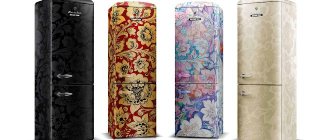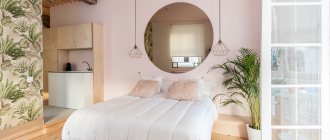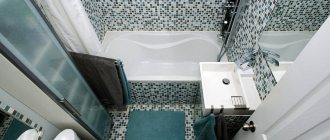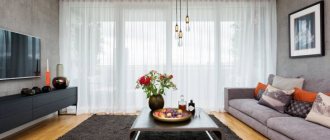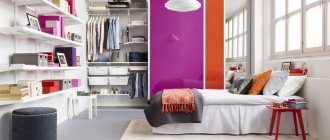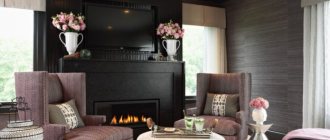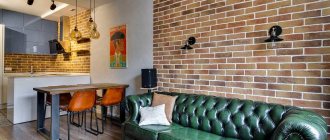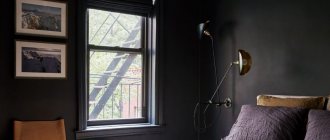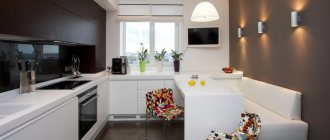Morocco remains for many of our compatriots a distant and unknown country, located somewhere in Africa. In fact, the geographical location makes the state the owner of unique climatic conditions. Morocco is comfortably located in the north-west of the African continent, but at the same time it is separated from the Spanish coast by only 14 km of the Strait of Gibraltar. The state is sometimes called the “country of four seasons.” In the morning you can climb the Atlas Mountains, during the day you can experience the scorching heat of the Sahara Desert, and in the evening you can swim in the warm waters of the Mediterranean Atlantic Sea. More than 95% of Moroccans are Muslims, so they treat guests with special attention and honor. The furnishings of the houses fit into the general design concept of the East, but at the same time they are not devoid of specific elements that are unique to this country. The Moroccan style in the interior is not used so often, but due to its versatility, lightness, and laconicism, it fits seamlessly into both luxury homes and small apartments.
History of style formation
The history of the Moroccan style is closely connected with the path of development along which this state passed. Morocco has attracted the attention of conquerors since ancient times. They came to these lands and slowly but surely survived the Berbers - the historical people who inhabited the country. Now this segment of the population makes up only 1/3 of the total population. The conquerors considered the Berbers to be invaders and bandits who illegally occupied advantageous positions near the trade routes passing through the Sahara. First they were attacked by the Phoenicians, and then by the Carthaginians.
Having fallen under the influence of the Roman Empire, the Moroccans finally learned about a quiet life and encountered Christianity for the first time. Peace reigned for only a couple of centuries until the Arabs conquered Morocco. Muslims overthrew the old religion and introduced Islam, which remained here. Closer to the 19th century, the country was again conquered by Europeans and became a colony. Britain, Germany, Spain and France fought for it. The latter took Morocco at its full disposal. Surprisingly, the French did not try to impose their style on local interiors. The features of the “indigenous” design were preserved and new ones were added.
As can be seen from its rich history, Morocco has been influenced by different peoples. All this was reflected in the features of the interior decoration of the rooms. The indigenous “Berber” movement was most strongly influenced by Moorish and Spanish styles (both close neighbors). In Moroccan interiors, rough “native” features, oriental, elegant Moorish motifs and light Castilian notes can be traced.
Moroccan style in the interior: Background
The original people of Morocco are the Berbers. However, for thousands of years, local life and culture were influenced by the Romans, later the Arabs and the Spaniards. In the first half of the 20th century, Morocco was a French protectorate.
All this has left its mark on local arts and crafts and traditional interior design. It mixed southern European, Berber and Arabic traditions, which ensured the exceptional originality of the Moroccan style.
Style Features
Modern Moroccan style has almost no differences with a similar style that was used in home decoration many centuries ago. Think about where the country is located and it will become clear why home for a Moroccan has become an oasis, a corner for relaxation, peace, reflection and intimate conversations with loved ones. This piece of personal space should stand out among the monotonous desert, please the eye and encourage a pleasant pastime. Comfort comes first, followed by beauty, and only in third position is functionality.
Among the main features of the Moroccan style are:
- Use of rough parts. This trend is primarily ethnic, so it uses vintage elements that are characteristic of the Berbers.
- Small-sized furniture. The luxury and color of the decor is achieved through the abundance of textiles and a palette of colors. Furniture fades into the background and becomes significantly smaller, that is, only poufs, low tables, and couches are used. Alternatively, the seating area can be made up of just pillows laid directly on the floor.
- Geometric shapes. Moroccan interiors contain shapes that are unusual for Europeans. A signature feature of Moroccan houses can be considered arched passages, the dome of which looks like a keyhole or is extended to a sharp tip crowning the middle.
- The decor uses colored glass (mosaics), glazed tiles with original oriental patterns, an abundance of colorful textiles, wood, and stone.
Polished wooden surfaces are considered too dull in Morocco. They are necessarily decorated with intricate carvings, which echo the ornate patterns on the walls.
An ideal direction for decorating country houses, dachas, and cottages. The main criterion in this case is location in nature. Traditionally, Berber homes have large windows that overlook either a picturesque backyard or a street with the beauty of the local landscape. There is no better addition to ethnic decoration than a natural, natural environment.
Main features and character
Moroccan interiors will appeal to both fans of primitivism and lovers of luxury. Such an interior is both varied and not at all tiring. First of all, it will be appreciated by lovers of non-standard solutions. But not only them.
This style is characterized by a combination of luxury, comfort and coziness.
This design is perfect for:
- for those who love order - every element of the decor is in its place;
- for minimalists - large rooms filled with air and light, clutter of furniture and things are eliminated;
- for connoisseurs of oriental exoticism.
This design will perfectly decorate both a large mansion and a cozy apartment. And all because of its originality and uniqueness. Nobody fetters the wings of your imagination here.
Living room in Moroccan style in red shades
White living room with a dome-shaped niche
A characteristic feature of the Moroccan style is the combination of bright colors and textures. Here you will find the roughness of nomads, complex African patterns, and European elegance of furniture.
Moroccan style in the interior is not afraid to combine bright colors. This is its main feature. First of all, these are warm sunny and golden shades. The most popular is the combination of red and gold. The decorator, working in this direction, must give the room impulsiveness and passion through the play of color, so combinations can sometimes be daring and provocative.
Natural colors of Africa, reminiscent of the outlines of the desert, jungle and fiery sun, are suitable for Moroccan design
Blue color can be used to decorate walls, ceilings and floors
When decorating, the tones of “earth dust” must be present:
- bronze;
- ocher;
- umber;
- shades of brown.
These natural shades will be the perfect canvas for brighter accents:
- purple;
- red;
- blue;
- green of various shades.
Bright bedroom decor in Moroccan style
Moroccan style bed
Everything here is built on harmony and interaction of cold and warm tones. The walls are usually plastered with exquisite and warm Moroccan plaster, giving it a marble look. This happens due to the peculiarities of its texture. The coloring is fundamentally monochromatic. Moroccan interior design includes the use of predominantly natural materials such as stone and wood. Since this country has a hot climate, the style solution is to decorate the room from floor to ceiling with small tiles. But this technique is not at all necessary for decorating residential premises, while for the bathroom it will come in handy.
Indian-style lamps, mesh lampshades and colored glass lamps are suitable for lighting.
The emphasis is on creating intimate lighting with the help of cute lamps, floor lamps with original weaving
Furniture plays an unusual role here, because in the foreground are auxiliary items - cabinets, benches, poufs, exquisite footrests. The place of classic sofas is taken by podiums under a canopy, decorated with many pillows of various shapes and sizes. But this does not mean minimalism in furniture; on the contrary, furniture emphasizes the status of the owner of a house or apartment.
A lot of auxiliary furniture is a distinctive feature of the Moroccan style
Tall furniture is not welcome, but low and wide furniture will come in handy
Low sofa with bright soft pillows
The average person might be creatively shocked by the amount of drapery in one room, but that’s how it’s meant to be. An abundance of curtains, draperies, canopies, pillows and bedspreads with a pronounced texture. The most popular fabrics here are organza, velvet and silk.
The main role of textiles is to create harmony and comfort in a room
Carpets are used both traditionally on the floor and on the walls. In African motifs, the tricolor rule does not work; complex patterns with iridescent shades are used here.
Color spectrum
The basis of the color scheme is warm shades. Moroccan interiors are bright and colorful, but the decor is not devoid of oriental elegance. The color palette is dominated by red, pink, burgundy, wine, coral, fuchsia, peach, yellow, and brown. The influence of the East can be seen in the use of blue, light blue, lilac, and turquoise. For interior decoration, traditional combinations such as red with gold (yellow), sky and orange are used. Through the use of luxurious colors, the style claims to be high luxury, akin to Baroque and Rococo chic. Ideas for decorating rooms are drawn from nature itself: the red-orange sunset sun, the pale yellow of the sand, the aquamarine shimmer of the sea, the gold of endless expanses to the very horizon.
Decor
For most interior styles, there is always a caveat: don't get too carried away with the decor, as there is a chance of ruining the look. With the Moroccan style, everything is exactly the opposite. Have fun, to your health! Not scary, even if a little too much. Of course, there is a chance to fill the entire apartment with accessories so that there is nowhere to step, but unless you go to extremes, it is quite difficult to make the decor redundant. Redundancy is a feature of the Moroccan style.
What accessories can you use? Handmade clay products, painted plates, vases, and figurines in oriental style will fit perfectly.
Elegant Moroccan lantern as decoration
Mirrors are a must for decor! They are very popular in the homeland of style, and no interior is complete without mirrors. It is desirable that even the frame be beautiful, eye-catching, as in the photo below.
Mirror - a must-have in the Moroccan interior
Bright embroidered pillows, patterned rugs and bedspreads, numerous carpets - all this must also certainly be present in the interior. Give preference to the following materials: velvet, organza, silk.
Patterned embroidered pillows – the more the merrier!
In the Moroccan style, chandeliers, that is, the central light, are rarely used, and numerous lamps can be considered decorative elements. They are made of colored glass or hidden under a beautiful twisted lattice.
Multi-colored lanterns are a popular decor in Moroccan style
Materials and finishing methods
The design uses a combination of wood and stone. Houses in Morocco are built from these materials. The ceiling can be plastered, but the joint between it and the wall must be decorated with a carved frieze. An alternative to plaster would be small tiles or a non-standard option - wooden panels decorated with carvings. Attaching such splendor to the ceiling with your own hands is very problematic. A complex frame base will be required, so it is better to seek the help of professionals. Since Moroccan houses have high ceilings, such a solution looks organic, but in typical domestic apartments, alas, this option will eat up valuable centimeters. Ceramic tiles are used to decorate all surfaces and the reason here is not only its beauty, but also its ability to “cool” the room.
Since the country is located in Africa, it is characterized by temperature changes and scorching heat during the day, so local residents sought refuge in the coolness of their homes. The tiles chosen are bright, patterned and small. Large pieces, which are often used to decorate kitchens and bathrooms, are not suitable in this case. You should choose special mosaic tiles with thematic patterns: rhombuses, octahedrons, stars, squares and other geometric shapes.
Features of Moroccan style
Moroccan style in the interior of a modern home is the choice of those who love ethnic design. It is quite eclectic, since, as already mentioned, it is a mix of interior design traditions inherent in various peoples inhabiting North Africa and Southern Europe.
Curtains and carpets in Moroccan style
Curtains in the Moroccan style are designed to create cool twilight in rooms and protect from the heat. As a rule, to sew them I use fabrics of rich colors: ocher, brown and red.
Carpets also occupy a special place in the Moroccan interior. They can be either traditional Berber or Arabic. Arabic options have a more attractive design and traditionally cost more. They are usually used when decorating a bedroom or living room in a Moroccan style. As for Berber carpets, they are laid on the floor in the hallway.
Moroccan style: tiles and other finishing options
Moroccan style in the interior of an apartment or private house can have different finishes, from the simplest to quite complex and expensive.
In particular, both simple plastering of walls and cladding with natural stone are equally acceptable.
The main facing material is mosaic or small ceramic tiles with a characteristic ornamental pattern.
Real Moroccan tiles are hand-painted with colored enamel, so they are quite expensive. It is made in the shape of squares, octagons, hexagons, triangles, crosses and diamonds. This allows you to assemble entire mosaic panels from such ceramics with a fairly complex and recognizable pattern.
The use of arches and niches will help to emphasize the Moroccan style in the interior. They should have a silhouette that follows the silhouette of the mosque dome. In a city apartment, this decor can be achieved using plaster or marble pilasters, complemented by the same stucco arches.
To create an imitation of a deep niche, you can use decorative lighting around its perimeter and a contrasting finish on the inner surface.
Hanging inside the deep niche of a traditional lamp is widely used.
Furniture in Moroccan style
As you know, the famous Atlas cedars grow in Morocco. Their wood is used to make chic furniture with a traditional silhouette. First of all, these are low octagonal tables. They are inlaid with pieces of various types of wood, mother-of-pearl, cupronickel, etc.
Chests of drawers and nightstands with paintings are also known throughout the world. One such product is enough to highlight the Moroccan style in the interior of a minimalist bedroom or living room.
Chic handmade screens with gratings and carvings are even more in demand. They can be coated with dark or light furniture varnish or painted in a bright color. Such screens are ideal for zoning any room.
In particular, they can be used to separate the bath from the bedroom or the kitchen from the living room. In addition, they are mobile, so you can change the layout and geometry of the room in a couple of minutes.
Furniture
The basis of the furniture set is made up of sofas. They are located in almost every room, and the more, the better. If possible, the entire perimeter is covered with sofas. They are covered with an armada of pillows. The sofas are accompanied by low coffee tables, not coffee tables. Although both of these concepts have merged into one, in Morocco they are actually used for drinking hot drinks in miniature cups, and not for storing periodicals in a special niche. By the way, there may be more than one table. A picturesque composition of several similar elements will become a bright decoration of the interior. Also used are trestle beds, couches, benches, and low chests of drawers. The furniture is made of solid wood with the addition of forged elements.
MOROCCAN STYLE IN YOUR HOME.
1. Moroccan style color scheme suggests choosing colors of spices such as cinnamon, pepper, saffron, curry and fiery sienna. This is a clear way to get an exotic “spicy” flavor from the interior. The cobalt blue accent will add a Moroccan feel to your atmosphere.
2. If you don't want to re-plaster the walls, try a suede-effect paint, a faux-effect paint, or even a mixture of a little sand and paint for a really textured look.
3. You will have to use a variety of fabrics, including Persian rugs and rugs. Use throws, tapestries and plenty of pillows in rich colors and rich patterns. For windows, choose light, light fabrics and draperies from the ceiling in the style of Bedouin canopies. The whole composition will look sensual and even luxurious!
4. Try using wrought iron screens as room dividers, which is very typical of Moroccan interior design.
Lighting
Lighting in the interior should be soft and not cause a desire to be obscured. Lamps are traditionally made of metal. The “shell” is decorated with oriental patterns. The decorative elements are called Moroccan lanterns. Their shape can be different:
- Rectangular lamps topped with a miniature dome with a hanging loop. They are placed either on the floor or threaded through special hooks in the walls.
- An elongated “spindle” shape with numerous ornaments and constrictions. They look organic not only in the interior of the room, but also on the terrace, open veranda, gazebo.
- “Spinning top” shape, but with soft transitions and rounded sides.
Ceiling chandeliers do not play such an important role as in European styles. The emphasis is on sconces, floor and table lamps. The lighting system is supplemented with wax candles, which will give the atmosphere a touch of oriental romance.
Lampshades are traditionally made from copper and brass using the forging method. Stamped elements can be purchased in specialized stores, but unique products will add a unique charm to the decor and become a “signature” in the author’s design.
Morocco in your home
Moroccan notes can be used when decorating interiors in rooms for any purpose. These can be either separate living rooms or the entire apartment.
Using Moroccan style in the interior
Large niches can accommodate another pouffe with pillows
Instead of sofas, you can place ottomans or couches
Fireplaces have lancet or arched vaults
The dining room is one of the few places where high chairs are allowed
In high rooms, both wooden beams and plaster ornaments can be attached to the ceiling
Accessories and decor
The decor is made exclusively from natural materials. The style originates in the mists of time, when plastic and composites simply did not exist. The materials are dominated by metal, glass, wood and clay. By the way, few decorative elements are used, because the luxurious paintings on the walls and the diversity of shades already make the interiors bright and original. Sofas and beds are decorated with numerous pillows, among which there are always elements of elongated shapes, traditional for the East.
Decorative niches in the walls are filled with metal plates on stands, elegant boxes, candlesticks on massive legs, vases with floral patterns, clay jugs and bowls. The tall windows are decorated with black metal bars. In hot climates they are rarely closed, so the element is more necessary for protection against uninvited guests.
Bathroom in Moroccan style
Moroccan design in a bathroom or bathroom is a tribute to originality and originality. Every time you visit, you will be left with a feeling of calm, coziness and comfort.
Decorating a bathroom according to oriental designs does not place excessive demands on the dimensions, shape and other features of the room. All features of the style can be reproduced in an ordinary city apartment or private household.
Three versions of "Morocco"
When decorating a Moroccan-style bathroom, three main design methods are used:
- Natural. Based on the authenticity of plumbing and finishing. A massive round sink made of rough faience, metal or stone is installed. It can be found at any large plumbing store. A classic Moroccan bathtub resembles a small swimming pool with powerful rectangular sides. It is separated from the main room using partitions, arches, etc.
- Ornamental. Oriental patterns and paintings, wood carvings and openwork decorations appear in the interior. Even one cabinet made in Moroccan style will give the bathroom an oriental flavor.
- Color. The main colors of Morocco are beige, brown, blue and their many shades. The classic European combination of white and blue is not used in the design of Moroccan premises.
Design and finishing
Recreating the style of ancient Morocco begins with the design of a traditional arch. It is made of plasterboard and covered with waterproof paint. Oriental mosaic is used for further finishing.
Waterproof ceramic tiles for bathrooms are laid on the walls and floors. It has a matte non-slip surface and a rich palette of shades. The material for decorative finishing is selected based on the standard requirements of Moroccan style:
- Small sizes. It is advisable to use tiles measuring 10*10 cm or less. It is inappropriate to use individual pieces and assemble them like a puzzle.
- Ornament. In this capacity, both geometric patterns and Arabic script, mosaics or images of plants are used. Oriental designs can be present not only on ceramic tiles, but also on mirror frames, plumbing fixtures, and dishes.
Situation
A peculiarity of the Moroccan style is the abundance of carved and painted details in the interior. An unusually shaped lamp in a wooden case, a small chest for linen and similar little things attract attention and leave the impression of a full-fledged oriental style.
It is not allowed to use plastic and polyethylene curtains for arranging partitions. Zoning a room or isolating a bathtub is done using wooden elements.
An abundance of mirrors, carved lamps and other decorations ennobles and enriches the interior. Also in the bathroom you need to equip one or more small arched niches where you can place personal hygiene products, lighting fixtures and other useful things.
Types of a Moroccan-style bathroom
Beige colors, authentic appliances and furniture are used
In any Moroccan room you can see many carvings
The highlight of the style is plain azure, burgundy, green surfaces
The walls are decorated with mosaic tiles creating a single pattern
The role of textiles in style
Textiles play the main style-forming role. Only natural fabrics are chosen: silk, wool, linen and cotton. There are textiles in almost every corner of the room: in upholstery, elegant pillowcases, heavy and light curtains, airy curtains, canopies over the bed, handmade rugs. If upholstered furniture has an unattractive coating “from the manufacturer,” then it is covered with covers and bedspreads. It is advisable to use unique textile products that you can even make yourself. The fabrics are decorated with a thematic oriental pattern, which is continued in the surfaces of ceramic tiles.
Textile design
There are a lot of textiles in the Moroccan interior: decorative pillows and homespun carpets decorate the floors and walls. Beds and sofas are under canopies and covered with blankets. The walls are decorated with draperies similar to Bedouin awnings.
On the windows there are curtains with folds and tassels made of light light fabric - brocade or silk, on which an oriental pattern is applied.
The style prefers organza, velvet and silk bright fabrics. Embroidery and gold trim create complex African patterns with iridescent shades.
Kitchen interier
The walls and floor of the Moroccan kitchen are tiled. To highlight the apron against its background, you can use neutral “natural” shades: sand, cobalt, brown. Furniture is chosen from wood with roughly processed surfaces. Hanging shelves are decorated with metal and clay plates, pots, and vases.
If the kitchen is combined with a dining room, then a group of Moroccan lamps of different shapes with a metal “frame” is hung above the dining table. The chairs are made of wood covered with carvings. The decoration is completed with a couple of pots with indoor plants.
Living room decoration
The living room is considered the favorite room of Moroccans, as it is where visitors and household members gather. A mandatory attribute for this room is a sofa. It should be as long and large as possible. If the dimensions of the room allow, then it is decorated with a sofa “series” around the perimeter. The windows are covered with heavy curtains and airy tulle. The walls are decorated with carved panels, ceramic tiles, wall lamps, niches with themed decorations. The ceiling is supported by decorative columns.
Bedroom in Moroccan style
The Moroccan bedroom, like other rooms, has a minimal set of furniture: a wide bed, a couple of bedside tables and a table. If the room is spacious, then a traditional sofa (couch, trestle bed) with a coffee table is placed nearby. The accent wall at the head of the bed is decorated with a niche that has a traditional oriental dome with an elongated tip. It is decorated with a composition of ceramic, glass, clay or wooden elements. The ceiling is crowned with a small chandelier, and sconces are installed symmetrically on both sides of the bed. The windows are decorated with wrought iron bars. Cover them with airy tulle. The floor must be covered with rugs. They polish the composition using a hookah, indoor plants in pots, plates of fruit and oriental sweets on the tables.
Who is the oriental interior suitable for?
A room decorated in Moroccan style will appeal to many, but not everyone will be able to live in it permanently.
Oriental interior will suit several types of people:
- Lovers of order. Each element of the decor has its own meaning and is placed in a certain place. Any change leads to a violation of harmony.
- Minimalists. Moroccan style means large rooms filled with light and air. A clutter of furniture and things is excluded, small chests and mats are welcome.
- For lovers of experiments and the East. To create an authentic Moroccan interior, you need to have an idea of the history and culture of the country, its main traditions and beliefs.
Bath and toilet design
The walls and floors in the Moroccan-style bathroom are decorated with small tiles with traditional patterns. The modern shower stall is being abandoned in favor of a luxurious bathtub. The sink is used with an overhead cover. An original solution would be to buy a specimen made of stone, which is highly expensive but will last for decades. The facades of cabinets for storing towels and household items are decorated with fine grids. If the ceilings are high, then a vaulted frame structure is installed above the bathroom, complemented by open shelves on the sides.
You can spy on the Moroccan style in numerous themed cafes and restaurants. Oddly enough, catering facilities honestly reflect the ethnic characteristics of the environment and do not allow the appearance of details that are not typical for it. Of course, to get inspired, you can go to the country where this trend originated. Luxurious, endless landscapes, picturesque sunsets, the horizon line “quivering” from the hot air - this is what will help you find the right mood to create an original, unique interior in the Moroccan style.
Creating an oriental fairy tale: materials and finishing
The walls are best covered with Moroccan plaster (“tadelakt”), which is always distinguished by warm shades and allows you to create aristocratic, glossy surfaces. But as an alternative, if it is not possible to use “tadelakt”, the walls can be painted a uniform color or covered with suitable textured wallpaper, and decorated with a carved frieze at the junction with the ceiling. Hand-painted paintings, original Arabic patterns and ornaments are also welcome on the walls.
The ceiling is often plastered, however, if it is high, it would be appropriate to decorate it with wooden panels or coffering.
Moroccan-style floors are traditionally tiled with mosaics. But you can also use ceramic tiles, parquet boards, parquet and laminate.


